If you live in the northern regions of the world, there is no doubt in our minds that you have seen at least one Honeysuckle. These shrubs extend from Europe to Asia, all the way to the furthest reaches of North America. Their range is vast, stretching across continents, and their diversity ever vaster. One of the reasons that they are so recognizable is that Different Types Of Honeysuckles are beautiful flowers that bloom during the start of springtime.They come in various colors, shapes, and sizes, and have been cultivated for their looks for generations.
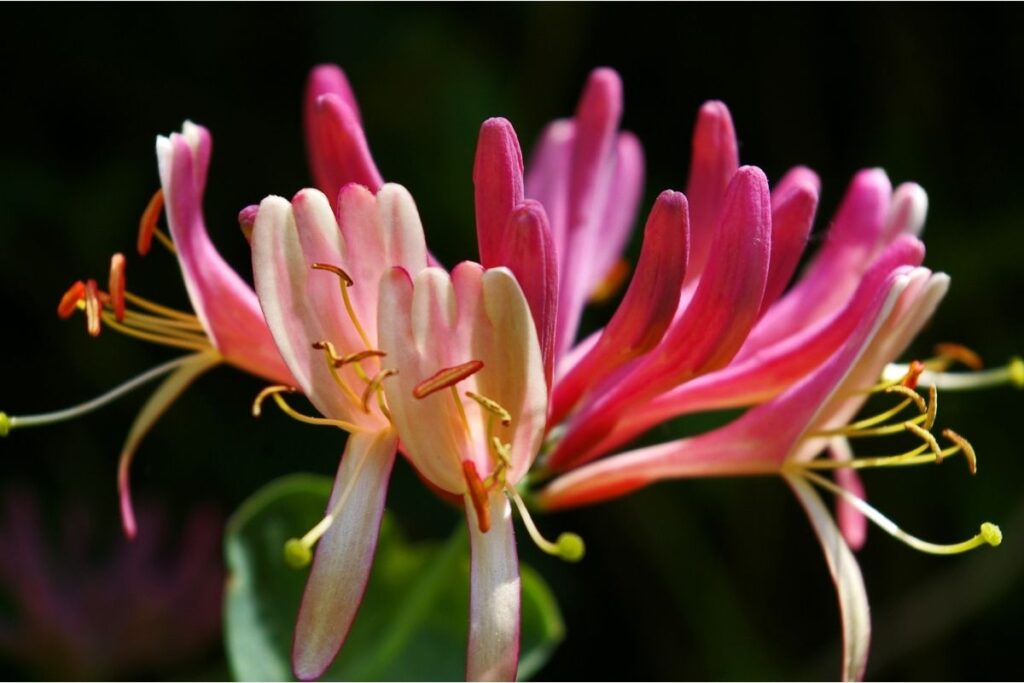
Yet, this is not the primary reason that people love Honeysuckle so much. The most recognizable factor of the plant is not their looks or their size, but their fragrance.
The smell is described as sweet and intense, it is often the first thing that people notice, long before they have actually seen the plant itself.
Due to these factors, people love to cultivate them in wild gardens that they are growing, or just to make their garden smell like spring.
The only problem is picking a kind of Honeysuckle to grow. Well, we’ve decided to help you with this today by listing the different kinds of Honeysuckle and the features that each plant has.
The Different Types Of Honeysuckle
Honeysuckles are a group of incredibly successful and adaptable plants.
This gives this list a bit of an issue, as with many successful plants in one family, there are a lot of different types of Honeysuckle. Over 180 different varieties to be exact.
Obviously, we can not talk about all of these varieties of Honeysuckle in one relatively short list. Therefore, we will give a rundown of the most popular or the most sought after plants to inform and pique your interest, in case you were thinking about buying the plants themselves.
1. Japanese Honeysuckle
This particular type of Honeysuckle is probably the most common variety in the United States. It comes in two main forms: climbing and bush.
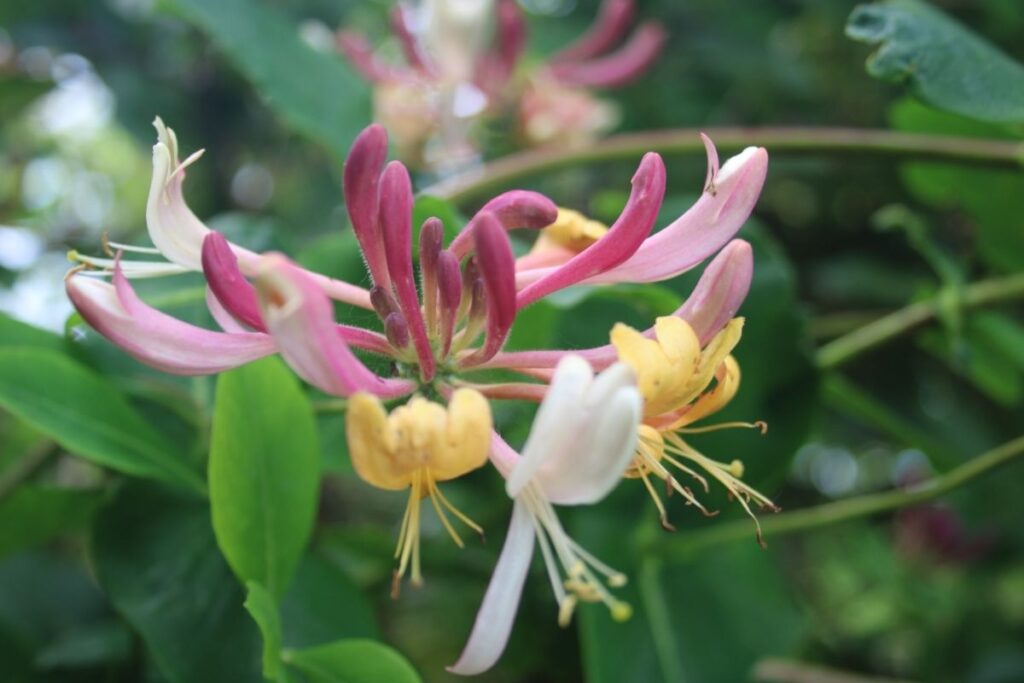
Climbing Japanese Honeysuckle grows up trees and over other structures, while the bush type grows on the ground. Both of these types of Honeysuckles grow upright stems that have leaves clustered around the base.
While this species is incredibly popular, it is important to note that it is tenacious and destructive in its habits.
While these are admirable traits for its survival, it has caused it to become an invasive species in many areas around the globe, including Australia, Argentina, Brazil, Mexico, the US, and New Zealand. If you do plan to grow or cultivate this plant, just make sure you tend to it properly.
The leaves of this Honeysuckle are somewhat similar in texture to the leaves of Ivy, which makes sense considering how closely related they are, but they are more oval shaped while being also very long and narrow, with most leaves reaching 3 inches in length and being 1 inch across. The leaves are also green, leathery, and they are covered in tiny hairs.
The flowers are tall, erect, and have two tongues filled with pollen poking out of their base. They are often bright yellow and white on alternating leaves.
2. Common Honeysuckle
This type of honeysuckle is commonly found throughout Europe and the northern parts of Africa. It can grow up to 7 meters and climbs whatever solid object is around it, whether that be tree or building.
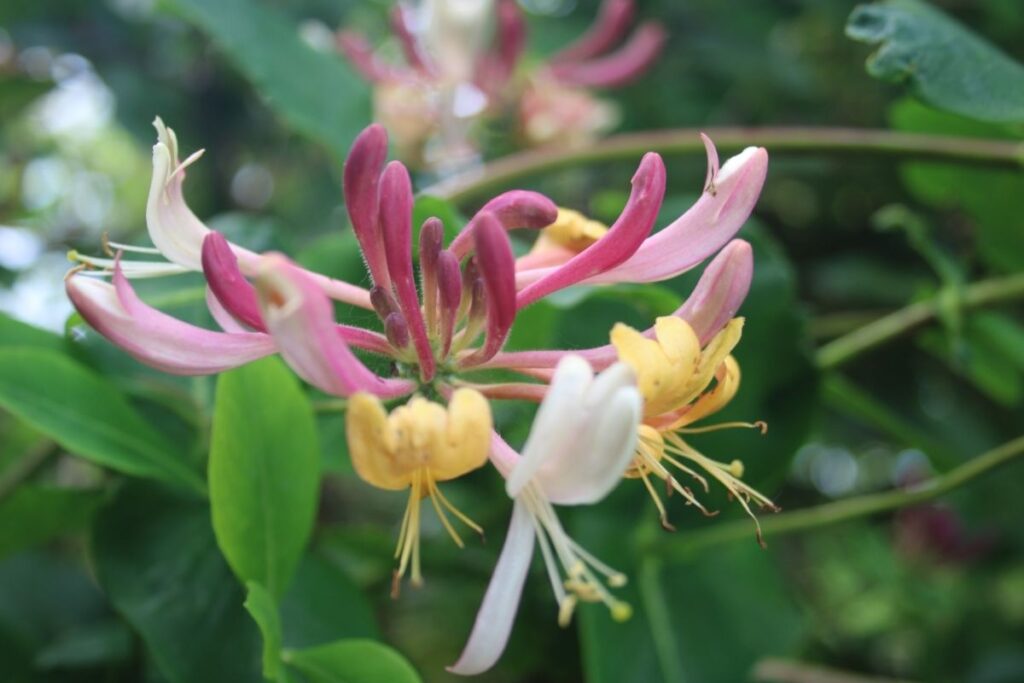
The flowers of this shrub are twofold and considered lip, with each curling over itself and the top one curling more dramatically than the bottom.
The tubular flowers are white and cream-colored on the outer petals, while in the inner petals and buds are a vibrant red. The display of this bloom is gorgeous in its contrast and is typically cited as a reason to buy the plant itself.
This Honeysuckle is one of the sweetest smelling plants and attracts not only insects with its fragrance and nectar, but many gardeners as well who use the plant for ornamental and mood setting garden designs. If you plan to grow this Honeysuckle, it will need a fixed object to attach itself to in your chosen space.
3. Italian Honeysuckle
Although not as widespread as Common Honeysuckle, Italian Honeysuckle still pervades round the edges of Southern Europe. It is a large plant, growing up to 8 meters in length, and is most often found in woodland or in hedges.
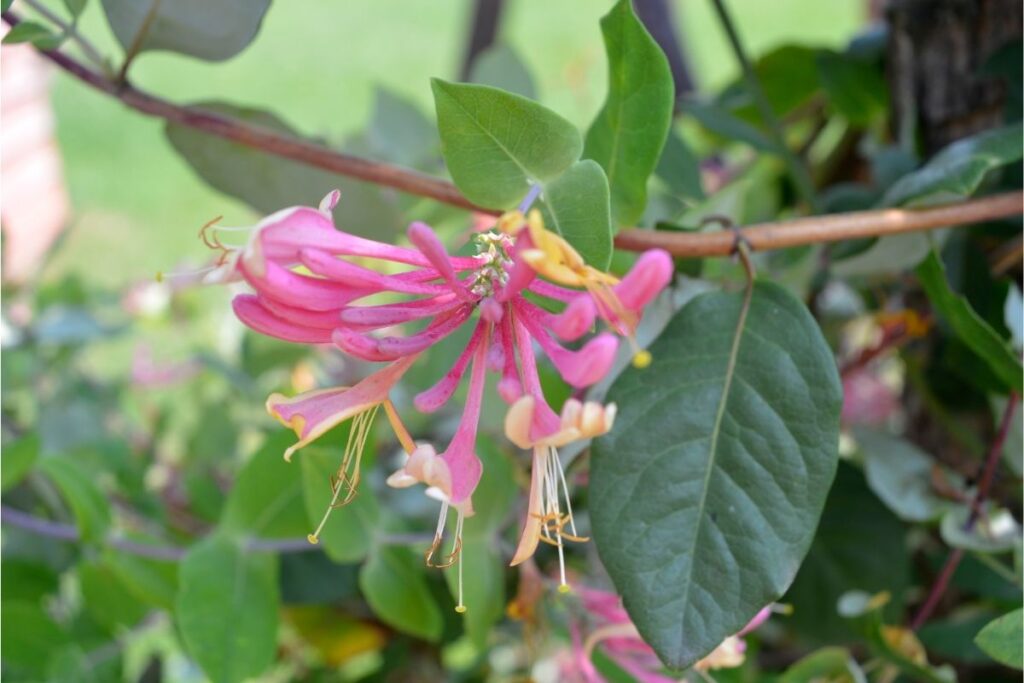
As before, the flowers are curled and double lipped, with two tongues sticking out from the center of the flower. Its color scheme is far more dramatic than that of its common cousin, however.
The outer flowers are a delightful light pink, while the inner buds and flowers are a deep, rich red. They are certainly striking and are well worth adding to your garden collection.
4. Tatarian Honeysuckle
This honeysuckle is native to the steppes and plains of Siberia and Central Asia, but has been introduced into North America for some time, where it is considered a pest and a noxious weed invading the area.
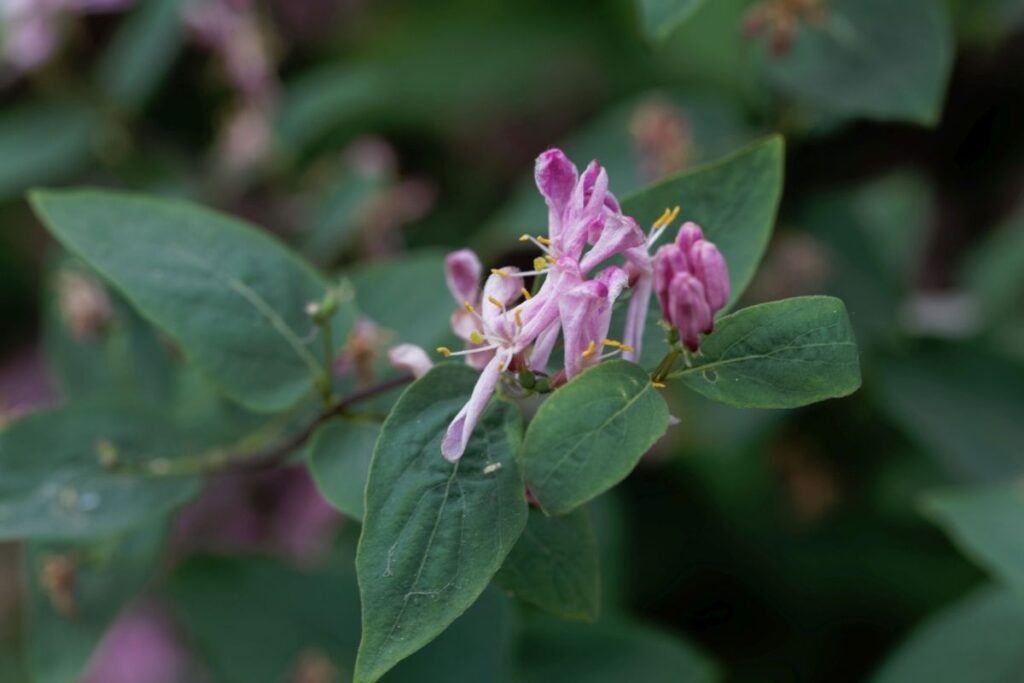
While not quite as large as its vine-like relatives, the Tatarian Honeysuckle can still grow up to 3 meters in height as a kind of multi-stemmed bush.
The leaves of this honeysuckle are long and oval shaped, while the flowers produce four petals. These petals are long and curl at the end with a wider cup like shape.
The petals have a fluffy texture and are a beautiful pinkish white with little yellow stamens poking out of the center.
As with Japanese Honeysuckle, this species is highly invasive, so be careful when planting.
5. Fly Honeysuckle
The Fly Honeysuckle is native to both the US and Canada, but is mostly found in the northeastern areas of both. This honeysuckle is another vine-like plant, like the Common Honeysuckle before it, and it can grow up to 2 meters in vertical length up an object.

The Fly Honeysuckle produces flowers that are long, tubular, and face downwards. They are one complete flower until the end, where the flower splits into five different lobes that are triangular and end in points.
These flowers can be compared to tiny bells, and the bright red fruit they produce attracts many creatures to them.
6. Winter Honeysuckle
Winter Honeysuckle is originally from China, but is popular as an ornamental plant for many international horticulturalists and the bane of many woodland managers for its invasive tendencies.
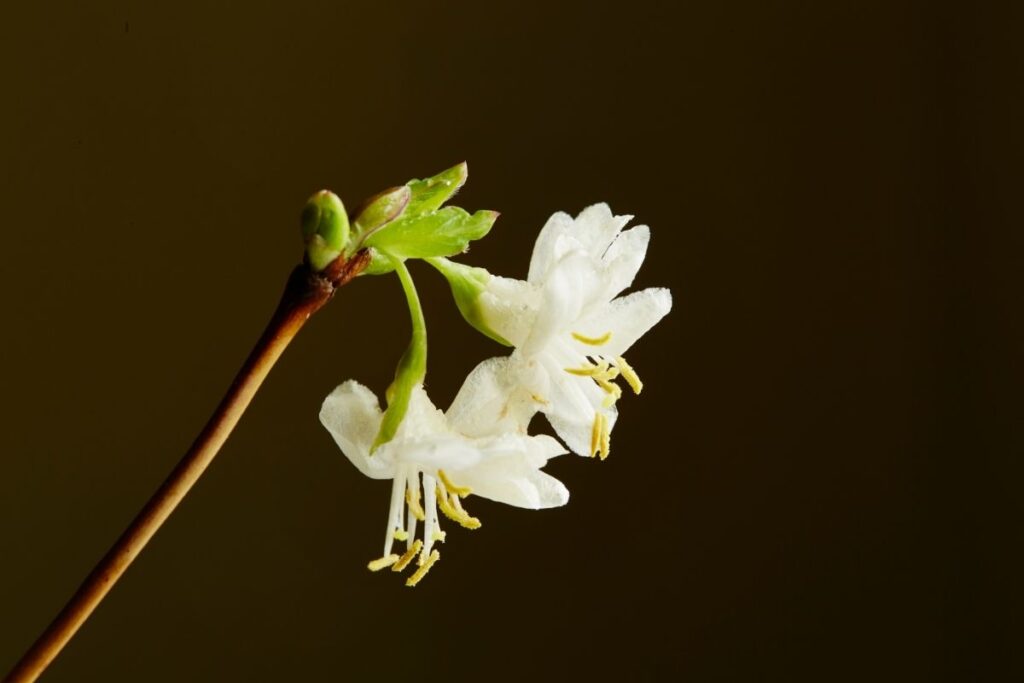
Being a semi-evergreen shrub, it can spring back to life when the conditions are right and has been observed doing so even in winter time, hence the name.
The plant can get to about 10 meters in vertical length and spread across an area of 100 inches. The plant can produce an abundance of white flowers that are short tubed and have 3 long lobes at the end of each one.
They are particularly prized as an ornamental plant, due to their sweet smelling fragrance.
7. Evergreen Honeysuckle
Another common type of honeysuckle, the Evergreen Honeysuckle, can also reach heights up to 4 meters tall, though not nearly as wide.
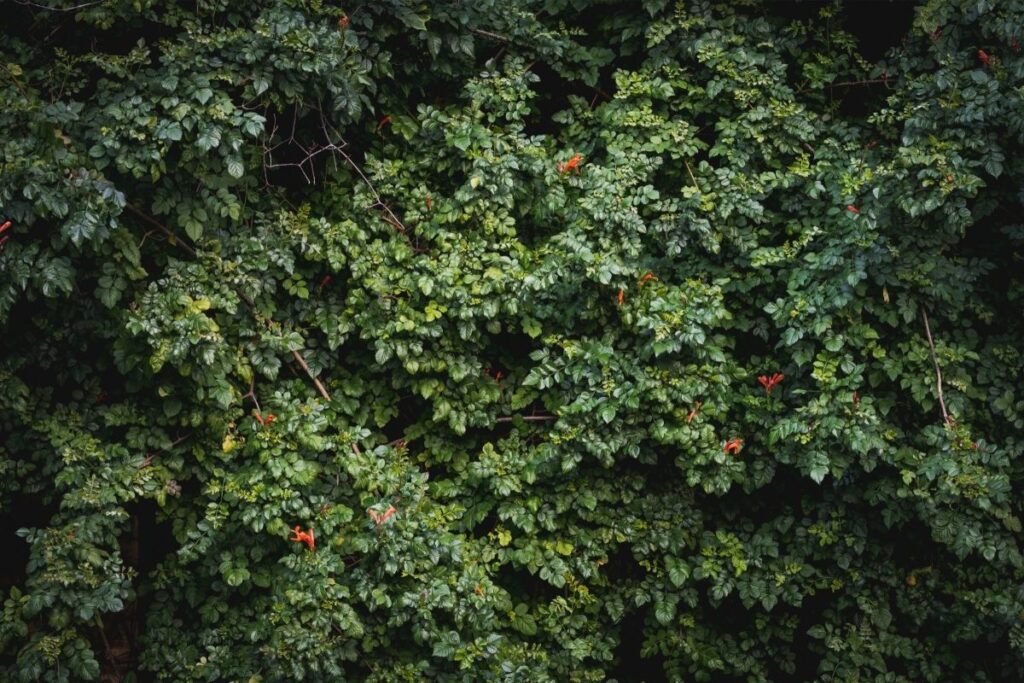
As the name suggests, these plants will always retain their leaves all year round, which makes them unique amongst other varieties and can work well for people who have gardens in the far north.
The flowers produced by the evergreen honeysuckle are very similar to those of the Winter Honeysuckle, except they are produced only once per season.
There are three lobes on the end of each tube shaped bud, and they are a lovely shade of purple on the outside of the flower, while the inside remains a gorgeous pure white.
8. Orange Honeysuckle
The Orange Honeysuckle is actually native to North America and is common in the wide Pacific rainforests of the northwestern United States. It can grow up to 6 meters in vertical length, and they tend to spiral the objects they grow around which helps them secure themselves, using their hollow twigs.
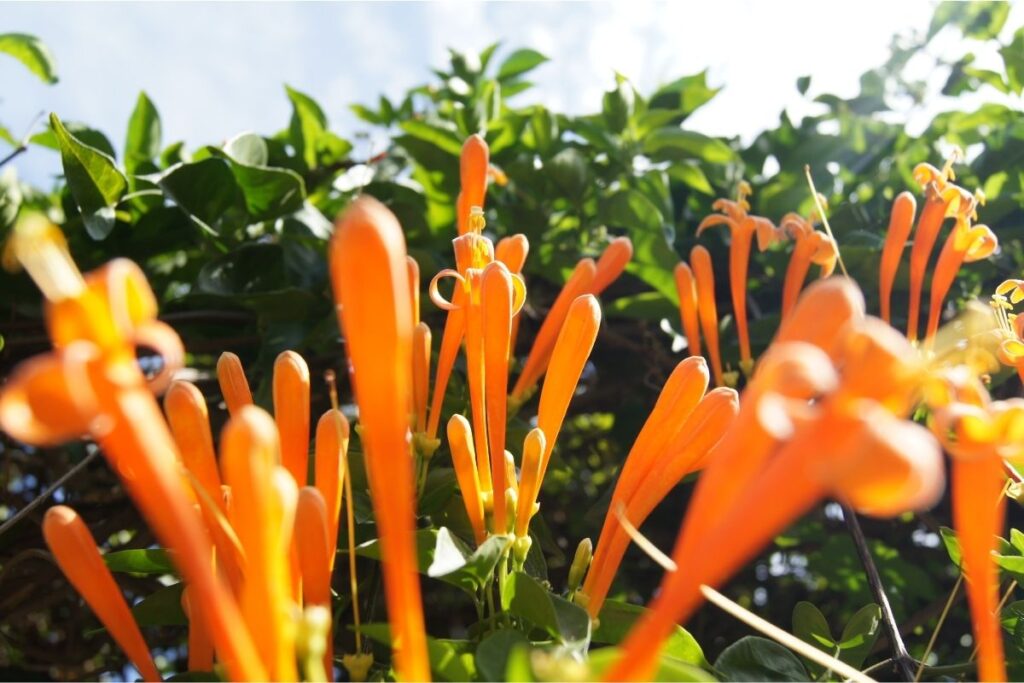
The flowers of this honeysuckle are quite long at about 1.5 to 3 inches, and they are trumpet shaped, until the end where they branch into 5 different lobes. The most striking thing about this plant is that the flowers and petals are all a mix of orange and yellow, very similar to that of a moving fire.
This makes them incredibly easy to spot and helps brighten up the woodland or meadow in which they reside.
9. Amur Honeysuckle
This honeysuckle is native to eastern Asia and Russia and is commonly grown in Korea, but is now endangered in Japan.
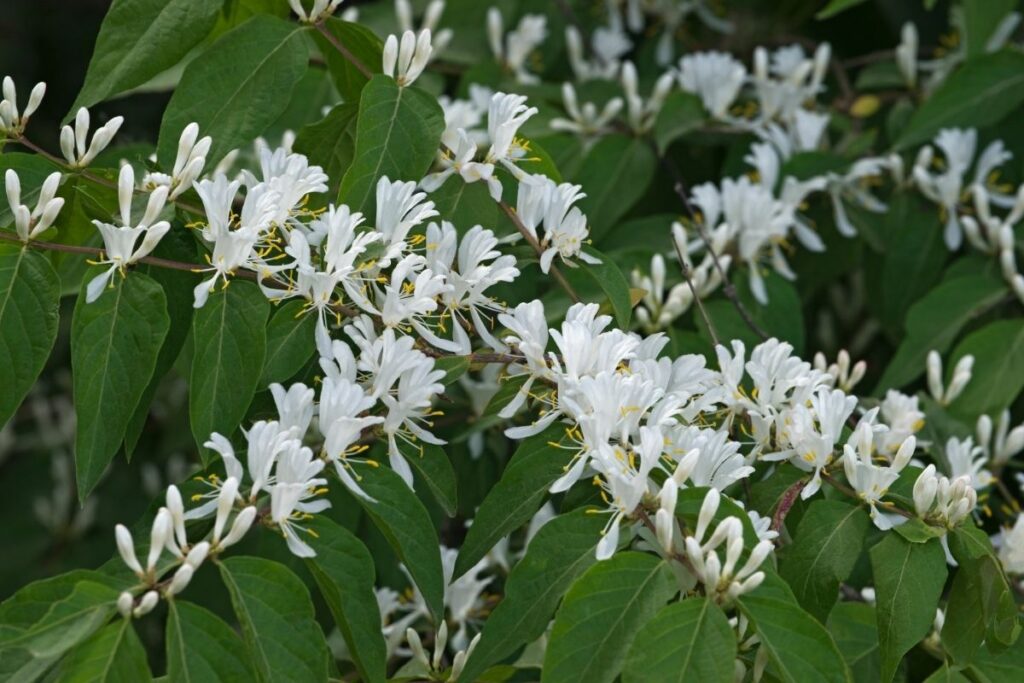
The Amur Honeysuckles grow close together and form a thicket that can get up to 8 meters high. As with the other honeysuckles, the Amur Honeysuckle creates a large bush that gets wider towards the top.
The flowers are produced early in the summer and are a whitish pink color. Each single blossom consists of two parts – a long tube with a bell shaped part at the bottom and then the pointy ends at the end that come out of the middle. These blossoms develop into beautiful fruits that look like small plums.
Conclusion
Honeysuckles are some of the most beautiful and interesting plants on the planets, if also alarmingly invasive and destructive at the same time.
They create wonderful flowers and fragrances that expand throughout an area and truly make it feel like you have brought the wild into your home.
If you wish to plant honeysuckles, just be careful of their potential to escape cultivation, as they are tenacious and invasive. Excluding that, though, they make a fabulous addition to anyone’s garden.







